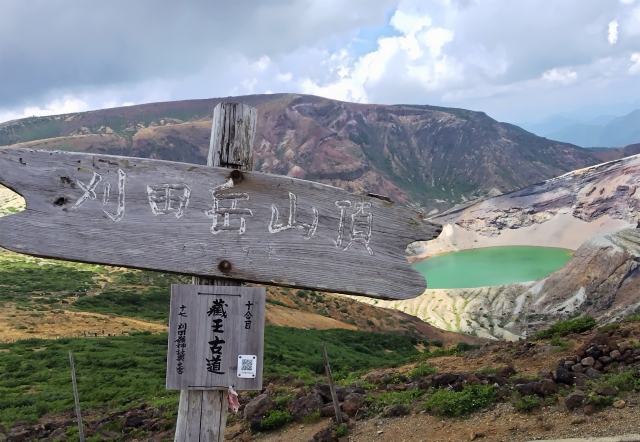Overview and characteristics of Okama
Okama is a crater lake located on the border of Zao Town, Katta District, Miyagi Prefecture, and Kawasaki Town, Shibata District, Miyagi Prefecture, and is also called Goshikinuma due to its beauty.
This area, located in the center of the Zao Mountain Range, is widely known as the symbol of the Zao Mountain Range. Furthermore, since it is close to the border between Miyagi and Yamagata prefectures, it is a popular tourist attraction in both prefectures.
This area is a caldera, and Okama is a crater lake surrounded by the outer rim and the central volcanic cone.
The water temperature of Okama Lake frequently rises due to volcanic activity, and its unique topography has led to it being likened to a cauldron. The origin of the name Okama is not clear, but it is thought to be related to changes in water temperature caused by the surrounding topography and volcanic activity.
Topography and history of Okama
Okama is located within a caldera located in the center of the Zao mountain range.
This region was formed by volcanic activity and has a very ancient history.
Zao’s volcanic activity is said to have started about 1 million years ago, and is thought to have existed for at least 700,000 years.
Approximately 30,000 years ago, a mountain collapsed and a caldera was formed.
Then, due to activity around 3,000 to 2,000 years ago, the eastern side of the sommayama collapsed, forming the C-shaped or horseshoe-shaped shape we see today.
Inside this somma, there is Goshikidake, a central cone with an altitude of 1,674 meters, and on the west side of the mountain there is an explosion crater with a diameter of approximately 400 meters. Okama was formed when water collected at the bottom of this crater, and it exists as a crater lake.
As a crater lake, the shoreline of Okama is 1080 meters long, with an east-west diameter of 325 meters, a north-south diameter of 325 meters, a maximum depth of 27.6 meters, and an average depth of 17.8 meters.
The topography of Okama has changed frequently due to volcanic activity, making it an interesting place where you can still see its historical changes.
History of tourism and research

Okama is known as an attractive spot for nature lovers and tourists, but its charm can’t be overlooked from a historical perspective either.
Below is information about Okama’s tourism and research history.
After the eruption in the Meiji period, Tadasuke Kochibe investigated Okama, and in the Taisho period, Fusakichi Omori and Shirota Kusakabe conducted research on volcanic activity.
In particular, the 1918 eruption that produced fumarole at Okama was a valuable source of information for researchers.
At the beginning of the Showa era, Toru Anzai of the former Yamagata High School took over Okama’s research and carried out a detailed survey by floating a boat on the surface of the lake.
At the time, researchers faced great hardships as observations required mountain climbing on foot or skis and long stays in tents.
Afterwards, ski huts and observation huts were built as bases for research, and research activities continued.
Anzai’s observations spanned more than 20 years, including winter, and the results were left behind for future generations.
The passion and efforts of researchers have contributed to the understanding of Okama’s volcanic activity and topography, and the scientific value of this area has increased. Even now, pores still exist at the bottom of the Okama lake, and volcanic gas continues to spew out.
With such a historical background, Okama is a place worth visiting for both tourism and science.
Basic information about Okama
| Name | Okama ■Location Miyagi Prefecture, Katta District, Zao Town, Togatta Onsen, Kuraishitake National Land, National Forest ■Business hours 9:00~17:00 ■Website visitmiyagi.com |
| Map |
SNS posting(#御釜)
Find and make reservations for nearby restaurants
Find a good restaurant and have the best tour!


Comments